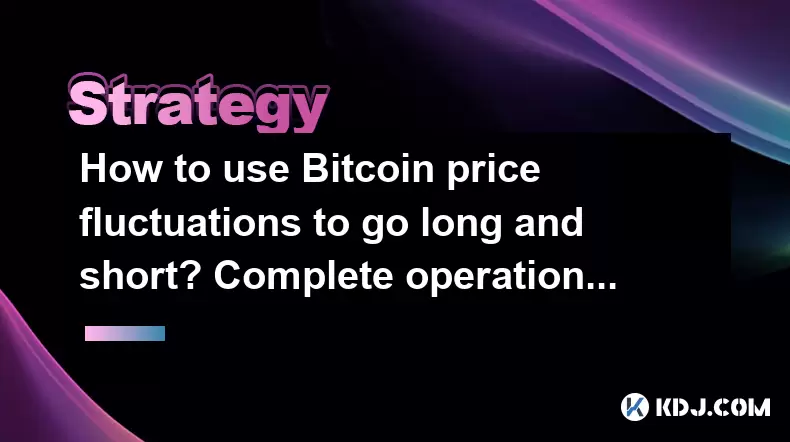-
 bitcoin
bitcoin $114320.977035 USD
-0.40% -
 ethereum
ethereum $4152.439985 USD
-1.75% -
 tether
tether $1.000111 USD
-0.04% -
 xrp
xrp $2.843037 USD
-1.63% -
 bnb
bnb $1013.349380 USD
-1.62% -
 solana
solana $208.362767 USD
-2.10% -
 usd-coin
usd-coin $0.999783 USD
0.00% -
 dogecoin
dogecoin $0.232559 USD
-1.00% -
 tron
tron $0.333491 USD
-1.09% -
 cardano
cardano $0.806310 USD
0.19% -
 hyperliquid
hyperliquid $45.023720 USD
-1.59% -
 ethena-usde
ethena-usde $1.000819 USD
-0.06% -
 chainlink
chainlink $21.241249 USD
-2.11% -
 avalanche
avalanche $30.035416 USD
-0.66% -
 stellar
stellar $0.364984 USD
-2.05%
How to use Bitcoin price fluctuations to go long and short? Complete operation process
Bitcoin's price swings offer trading opportunities; learn to go long or short using platforms like Binance, manage risks with stop-loss orders, and monitor positions actively.
Jun 02, 2025 at 05:29 pm

Bitcoin, the world's leading cryptocurrency, is known for its significant price fluctuations. These movements present unique opportunities for traders to profit by going long or short. This article will guide you through the complete operation process of using Bitcoin price fluctuations to go long and short, ensuring you understand every step involved.
Understanding Long and Short Positions
Going long on Bitcoin means you anticipate its price will rise. You buy Bitcoin at a lower price with the expectation of selling it at a higher price in the future. Conversely, going short means you expect the price to fall. You borrow Bitcoin to sell at the current market price, aiming to buy it back later at a lower price to return to the lender, pocketing the difference.
To effectively use Bitcoin price fluctuations, it's crucial to understand these concepts and how they apply to your trading strategy.
Choosing a Trading Platform
Selecting the right trading platform is the first step in your trading journey. Popular platforms like Binance, Coinbase Pro, and Kraken offer the necessary tools and liquidity for trading Bitcoin. Here's how to choose a platform:
- Research the platform's reputation and security measures.
- Ensure it supports the trading pairs you need (e.g., BTC/USD).
- Check for low fees and high liquidity.
- Evaluate the user interface and available trading tools.
Once you've chosen a platform, you'll need to create an account and complete the verification process, which typically involves submitting personal identification documents.
Setting Up Your Trading Account
After selecting a platform, you'll need to set up your trading account. Here's a detailed guide:
- Register on the platform by providing your email address and creating a strong password.
- Complete the KYC (Know Your Customer) process by submitting required identification documents.
- Enable two-factor authentication (2FA) for added security.
- Deposit funds into your account using a supported payment method, such as bank transfer or credit card.
Once your account is funded, you're ready to start trading.
Executing a Long Position
To go long on Bitcoin, follow these steps:
- Navigate to the trading section of your chosen platform.
- Select the BTC/USD trading pair.
- Enter the amount of Bitcoin you wish to buy.
- Set your order type. You can choose a market order for immediate execution or a limit order to buy at a specific price.
- Review your order details and confirm the purchase.
After buying Bitcoin, monitor its price closely. When you believe the price has reached its peak or you've achieved your desired profit, you can sell your Bitcoin to realize your gains.
Executing a Short Position
Going short on Bitcoin involves more steps, as you'll need to borrow the cryptocurrency before selling it. Here's how to do it:
- Ensure your trading platform supports margin trading and short selling.
- Navigate to the margin trading section.
- Borrow the amount of Bitcoin you wish to short.
- Sell the borrowed Bitcoin at the current market price.
- Monitor the price closely. When you believe the price has dropped sufficiently, buy back the same amount of Bitcoin at the lower price.
- Return the borrowed Bitcoin to the lender and keep the difference as profit.
Remember that short selling involves higher risk, as potential losses can exceed your initial investment if the price rises instead of falling.
Managing Risk and Setting Stop-Loss Orders
Effective risk management is crucial when trading Bitcoin. One of the most important tools at your disposal is the stop-loss order. A stop-loss order automatically sells your position if the price reaches a certain level, limiting your potential losses. Here's how to set one:
- Determine your risk tolerance and the maximum loss you're willing to accept.
- Calculate the stop-loss price based on your entry price and risk tolerance.
- Navigate to the order section on your trading platform.
- Enter the stop-loss price and the amount of Bitcoin you want the order to cover.
- Confirm the order.
Using stop-loss orders can help protect your capital and ensure you don't lose more than you can afford.
Monitoring and Adjusting Your Positions
Once you've entered a long or short position, continuous monitoring is essential. Here's how to effectively manage your positions:
- Regularly check the Bitcoin price and market news that could impact its value.
- Adjust your stop-loss orders if the price moves in your favor to lock in profits.
- Consider taking partial profits if the price reaches your target level.
- Be prepared to exit your position if market conditions change unexpectedly.
Active management can help you maximize profits and minimize losses in the volatile Bitcoin market.
Frequently Asked Questions
Q: Can I go long and short on Bitcoin simultaneously?A: Yes, it's possible to have both long and short positions on Bitcoin at the same time, a strategy known as hedging. This approach can help you profit from price movements in either direction but requires careful management to avoid excessive risk.
Q: What are the risks of short selling Bitcoin?A: Short selling Bitcoin carries significant risks, including the potential for unlimited losses if the price rises instead of falling. Additionally, you'll need to pay interest on the borrowed Bitcoin, which can eat into your profits or increase your losses.
Q: How do I determine the right time to enter a long or short position?A: Timing the market is challenging, but you can use technical analysis, chart patterns, and market indicators to identify potential entry points. Additionally, staying informed about market news and sentiment can help you make more informed decisions.
Q: Are there any fees associated with trading Bitcoin?A: Yes, trading Bitcoin typically involves fees, including trading fees, withdrawal fees, and, in the case of short selling, borrowing fees. These fees can vary between platforms, so it's essential to understand the fee structure before you start trading.
Disclaimer:info@kdj.com
The information provided is not trading advice. kdj.com does not assume any responsibility for any investments made based on the information provided in this article. Cryptocurrencies are highly volatile and it is highly recommended that you invest with caution after thorough research!
If you believe that the content used on this website infringes your copyright, please contact us immediately (info@kdj.com) and we will delete it promptly.
- BlockDAG, DOGE, HYPE Sponsorship: Crypto Trends Shaping 2025
- 2025-10-01 00:25:13
- Deutsche Börse and Circle: A StableCoin Adoption Powerhouse in Europe
- 2025-10-01 00:25:13
- BlockDAG's Presale Buzz: Is It the Crypto to Watch in October 2025?
- 2025-10-01 00:30:13
- Bitcoin, Crypto, and IQ: When Genius Meets Digital Gold?
- 2025-10-01 00:30:13
- Stablecoins, American Innovation, and Wallet Tokens: The Next Frontier
- 2025-10-01 00:35:12
- NBU, Coins, and Crypto in Ukraine: A New Yorker's Take
- 2025-10-01 00:45:14
Related knowledge

Practical parameter settings for a Bitcoin multi-timeframe moving average system
Sep 18,2025 at 10:54pm
Optimizing Timeframe Combinations for Bitcoin Trading1. Selecting appropriate timeframes is crucial when building a multi-timeframe moving average sys...

How can I filter out false breakouts in Dogecoin high-frequency trading?
Sep 22,2025 at 01:00am
Understanding False Breakouts in Dogecoin Trading1. A false breakout occurs when Dogecoin's price appears to move beyond a defined support or resistan...

Techniques for identifying tops and bottoms in the Bitcoin on-chain NVT model
Sep 20,2025 at 07:54pm
Understanding the NVT Model in Bitcoin Analysis1. The Network Value to Transactions (NVT) ratio is often described as the 'P/E ratio' of the cryptocur...

What does the surge in open interest in Bitcoincoin futures mean?
Sep 20,2025 at 11:18pm
Understanding the Surge in Dogecoin Futures Open Interest1. A surge in open interest within Dogecoin futures indicates a growing number of active cont...

How can I use the Ethereum USDT premium to gauge market sentiment?
Sep 18,2025 at 11:55pm
Understanding the Ethereum USDT Premium1. The Ethereum USDT premium refers to the price difference between USDT (Tether) traded on Ethereum-based plat...

What should I do if Ethereum staking yields decline?
Sep 20,2025 at 06:18am
Understanding the Causes Behind Declining Ethereum Staking Yields1. The Ethereum network transitioned to a proof-of-stake consensus mechanism with the...

Practical parameter settings for a Bitcoin multi-timeframe moving average system
Sep 18,2025 at 10:54pm
Optimizing Timeframe Combinations for Bitcoin Trading1. Selecting appropriate timeframes is crucial when building a multi-timeframe moving average sys...

How can I filter out false breakouts in Dogecoin high-frequency trading?
Sep 22,2025 at 01:00am
Understanding False Breakouts in Dogecoin Trading1. A false breakout occurs when Dogecoin's price appears to move beyond a defined support or resistan...

Techniques for identifying tops and bottoms in the Bitcoin on-chain NVT model
Sep 20,2025 at 07:54pm
Understanding the NVT Model in Bitcoin Analysis1. The Network Value to Transactions (NVT) ratio is often described as the 'P/E ratio' of the cryptocur...

What does the surge in open interest in Bitcoincoin futures mean?
Sep 20,2025 at 11:18pm
Understanding the Surge in Dogecoin Futures Open Interest1. A surge in open interest within Dogecoin futures indicates a growing number of active cont...

How can I use the Ethereum USDT premium to gauge market sentiment?
Sep 18,2025 at 11:55pm
Understanding the Ethereum USDT Premium1. The Ethereum USDT premium refers to the price difference between USDT (Tether) traded on Ethereum-based plat...

What should I do if Ethereum staking yields decline?
Sep 20,2025 at 06:18am
Understanding the Causes Behind Declining Ethereum Staking Yields1. The Ethereum network transitioned to a proof-of-stake consensus mechanism with the...
See all articles










































































